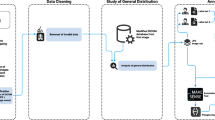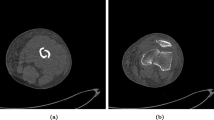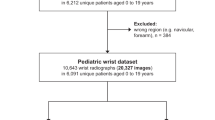Abstract
Imaging techniques widely use Computed Tomography (CT) scans for various purposes, such as screening, diagnosis, and decision-making. Of all, it holds true for bone injuries. To build fully automated Computer-Aided Detection (CADe) and Diagnosis (CADx) tools and techniques, it requires fairly large amount of data (with gold standard). Therefore, in this paper, since state-of-the-art works relied on small dataset, we introduced a CT image dataset on limbs that is designed to understand bone injuries. Our dataset is a collection of 24 patient-specific CT cases having fractures at upper and lower limbs. From upper limbs, 8 cases were collected from bones in/around the shoulder (left and right). Similarly, from lower limbs, 16 cases were collected from knees (left and right). Altogether, 5684 CT images (upper limbs: 2057 and lower limbs: 3627) were collected. Each patient-specific CT case is composed of maximum 257 scans/slices in average. Of all, clinically approved annotations were made on every 10th slices, resulting in 1787 images. Importantly, no fractured limbs were missed in our annotation. Besides, to avoid privacy and confidential issues, patient-related information were deleted. The proposed dataset could be a promising resource for the medical imaging research community, where imaging techniques are employed for various purposes. To the best of our knowledge, this is the first time 5K+ CT images on fractured limbs are provided for research and educational purposes.




Similar content being viewed by others
Notes
HIPPA: Health Insurance Portability and Accountability Act
IRB: Institutional Review Board
DICOM: Digital Imaging and Communications in Medicine
References
Han G., Liu X., Han F., Santika, et al., The LISS–a public database of common imaging signs of lung diseases for computer-aided detection and diagnosis research and medical education. IEEE Trans. Biomed. Eng. 62(2):648–656, 2014
Armato SG. III, McLennan G., McNitt-Gray M. F., et al., Lung image database consortium: Developing a resource for the medical imaging research community. Radiology 232(3):739–748, 2004
Sinha A. P., Study of orthopedic injuries pattern by road traffic accident victims. Int. J. Life. Sci. Scienti. Res 3(2):961–963, 2017
World Health Organization, et al., (2018) Global status report on road safety 2018: Summary. Technical report, World Health Organization
Ansari S., Akhdar F., Mandoorah M, Moutaery K., Causes and effects of road traffic accidents in saudi arabia. Public Health 114(1):37–39, 2000
Simina V., Najarian K., Automated bone segmentation from pelvic CT images. In: 2008 IEEE International Conference On Bioinformatics and Biomeidcine Workshops. IEEE, 2008, pp. 41–47
Velnar T., Bunc G., Gradisnik L., et al., Fractures and biomechanical characteristics of the bone. Surg. Sci. 6(06):255, 2015
Ruikar D. D., Santosh K. C., Hegadi R. S., Segmentation and analysis of CT images for bone fracture detection and labeling. In: Medical imaging Artificial Intelligence Image Recognition, and Machine Learning Techniques, 2019, p. 131
Ruikar D. D., Santosh K. C., Hegadi R. S., Automated fractured bone segmentation and labeling from CT images. J. Med. Syst. 43(3):60, 2019
Hounsfield G. N., Computed medical imaging. Med. Phys. 7(4):283–290, 1980
Balaji G. N., Subashini T. S., Madhavi P., Bhavani C. H., Manikandarajan A., Computer-aided detection and diagnosis of diaphyseal femur fracture. In: Smart Intelligent Computing and Applications. Springer, 2020, pp. 549–559
Ruikar D. D., Hegadi R. S., Santosh K. C., A systematic review on orthopedic simulators for psycho-motor skill and surgical procedure training. J. Med. Syst. 42(9):168, 2018
Sharma K., Virmani J., A decision support system for classification of normal and medical renal disease using ultrasound images: A decision support system for medical renal diseases. Int. J. Ambient Comput. Intell. (IJACI) 8(2):52–69, 2017
Sobrinho A., Da S., Queiroz A. C. M., Da Silva L. D., De Barros Costa E., Pinheiro M. E., Perkusich A., Computer-aided diagnosis of chronic kidney disease in developing countries: A comparative analysis of machine learning techniques. IEEE Access 8:25407–25419, 2020
Jiménez-Delgado J. J., Paulano-Godino F., Pulidoram-ramírez R., Jiménez-Pérez. J. R., Computer assisted preoperative planning of bone fracture reduction: Simulation techniques and new trends. Med. Image Anal. 30:30–45, 2016
Donnelley M., Knowles G., Hearn T., A cad system for long-bone segmentation and fracture detection. In: International Conference on Image and Signal Processing. Springer, 2008, pp. 153–162
Jiménez-Sánchez A., Kazi A., Albarqouni S., et al., (2019) Towards an interactive and interpretable cad system to support proximal femur fracture classification. arXiv:1902.01338
Testi D., Quadrani P., Viceconti M., Physiomespace: Digital library service for biomedical data. Philosophical Trans. R. Soc. Math. Phys. Eng. Sci. 368(1921):2853–2861, 2010
Ruikar D. D., Sawat D. D., Santosh K. C., Hegadi R. S., (2019) 3d imaging in biomedical applications: A systematic review (chap.8)
Zhang Y., Tong R., Song D., Yan X., Lin L., Jian W., Joined fragment segmentation for fractured bones using gpu-accelerated shape-preserving erosion and dilation. Med. Biol. Eng. Comput. 58(1):155–170, 2020
Shadid W. G., Willis A., Bone fragment segmentation from 3D CT imagery. Computer. Med. Imaging Graph. 66:14–27, 2018
Tassani S., Matsopoulos G. K., Baruffaldi F., 3d identification of trabecular bone fracture zone using an automatic image registration scheme: A validation study. J. Biomechan. 45(11):2035–2040, 2012
Paulano F., Jiménez J. J., Pulido R., 3d segmentation and labeling of fractured bone from ct images. Visual Comput. 30(6-8):939–948, 2014
Yoshii Y., Teramura S., Oyama K., Ogawa T., Hara Y., Ishii T., Development of three-dimensional preoperative planning system for the osteosynthesis of distal humerus fractures. BioMed Eng OnLine 19(1):1–13, 2020
Tomazevic M., Kreuh D., Kristan A., Puketa V., Cimerman M., Preoperative planning program tool in treatment of articular fractures: Process of segmentation procedure. In: XII Mediterranean Conference on Medical and Biological Engineering and Computing 2010. Springer, 2010, pp. 430–433
Paulano-Godino F., Jiménez-Delgado J. J., Identification of fracture zones and its application in automatic bone fracture reduction. Comput. Methods Programs Biomed. 141:93–104, 2017
Ruikar D.D., Santosh K.C., Hegadi R.S., Contrast stretching-based unwanted artifacts removal from ct images. In: International Conference on Recent Trends in Image Processing and Pattern Recognition. Springer, 2018, pp. 3–14
Montani S., Bellazzi R., Supporting decisions in medical applications: The knowledge management perspective. Int. J. Med. Inform. 68(1-3):79–90, 2002
Tomazevic M., Kreuh D., Kristan A., Puketa V., Cimerman M., Preoperative planning program tool in treatment of articular fractures: Process of segmentation procedure. In: XII Mediterranean Conference on Medical and Biological Engineering and Computing 2010. Springer, 2010, pp. 430–433
Fornaro J., Székely G., Harders M., Semi-automatic segmentation of fractured pelvic bones for surgical planning. In: International Symposium on Biomedical Simulation. Springer, 2010, pp. 82–89
Harders M., Barlit A., Gerber C., Hodler J., Székely G., An optimized surgical planning environment for complex proximal humerus fractures. In: MICCAI Workshop on Interaction in Medical Image Analysis and Visualization, Vol. 30, 2007
Huang C.-Y., Luo L.-J., Lee P.-Y., et al., Efficient segmentation algorithm for 3d bone models construction on medical images. J. Med. Biol. Eng 31:375–386, 2011
Sebastian T. B., Tek H., Crisco J. J., Wolfe S. W., Kimia B. B., Segmentation of carpal bones from 3d ct images using skeletally coupled deformable models. In: International Conference on Medical Image Computing and Computer-Assisted Intervention. Springer, 1998, pp. 1184–1194
Egol K. A., Koval K. J., Zuckerman J. D., Handbook of fractures Philadelphia: Lippincott Williams & Wilkins, 2010
Armato S. G. III, Meyer C. R., McNitt-Gray M. F., et al., The reference image database to evaluate response to therapy in lung cancer (rider) project: A resource for the development of change-analysis software. Clinic. Pharmacol. Therapeut. 84(4):448–456, 2008
Zhang Z., Yin S., Feng, Liu J., et al., Origa-light: An online retinal fundus image database for glaucoma. In: Conference proceedings :... Annual International Conference of the IEEE Engineering in Medicine and Biology Society. IEEE Engineering in Medicine and Biology Society. Annual Conference, 2010, pp. 3065–3068
Kälviäinen R. V. J. P. H., Uusitalo H., Diaretdb1 diabetic retinopathy database and evaluation protocol. In: Medical Image Understanding and Analysis, Vol. 2007. Citeseer, 2007, p. 61
Varma D. R., Managing dicom images: Tips and tricks for the radiologist. Indian J. Radiol. Imag. 22(1):4, 2012
Vannier M. W., Summers R. M., Sharing images. Radiology 228(1):23–25, 2003
Author information
Authors and Affiliations
Corresponding author
Ethics declarations
Ethical approval
All procedures performed in studies involving human participants were in accordance with the ethical standards of the institutional and/or national research committee and with the 1964 Helsinki declaration and its later amendments or comparable ethical standards.
Conflict of Interests
Authors declared no conflicts of interest.
Additional information
Publisher’s Note
Springer Nature remains neutral with regard to jurisdictional claims in published maps and institutional affiliations.
This article is part of the Topical Collection on Image & Signal Processing
The first two authors contributed equally to the work.
Rights and permissions
About this article
Cite this article
Ruikar, D.D., Santosh, K., Hegadi, R.S. et al. 5K+ CT Images on Fractured Limbs: A Dataset for Medical Imaging Research. J Med Syst 45, 51 (2021). https://doi.org/10.1007/s10916-021-01724-9
Received:
Accepted:
Published:
DOI: https://doi.org/10.1007/s10916-021-01724-9




